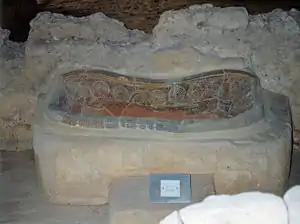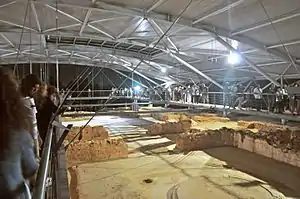Palace of Nestor
The Palace of Nestor (Modern Greek: Ανάκτορο του Νέστορα (Dimotiki); Ἀνάκτορον Νέστορος[1] (Katharevousa)) was an important centre in Mycenaean times, and described in Homer's Odyssey and Iliad as Nestor's kingdom of "sandy Pylos".[2]


The palace featured in the story of the Trojan War, as Homer tells us that Telemachus:
went to Pylos and to Nestor, the shepherd of the people, and he received me in his lofty house and gave me kindly welcome, as a father might his own son who after a long time had newly come from afar: even so kindly he tended me with his glorious sons.[3]
The site is the best preserved Mycenaean Greek palace discovered. The palace is the primary structure within a larger Late Helladic era settlement, once probably surrounded by a fortified wall. The palace was a two-storey building with store rooms, workshops, baths, light wells, reception rooms and a sewage system.
The settlement had been long occupied with most artifacts discovered dating from 1300 BC. The palace complex was destroyed by fire around 1200 BC.
In June 2016 the site re-opened to the public after the roof was replaced by a modern structure with raised walkways for visitors.[4][5][6]
Location

The site is on the hill of Epano Englianos, situated close to the road 4 kilometres (2.5 mi) south of Chora and 17 kilometres (11 mi) north of Pylos, at 150 metres (490 ft) above sea level and in an area of 170 metres (560 ft) by 90 metres (300 ft).
Excavations


In 1912 and 1926 two tholos tombs north of the Bay of Navarino were excavated. One contained three decorated jars and the other a collection of Early Mycenaean and Middle Helladic pots.
A joint Hellenic-American expedition was formed with the Greek Archaeological Service and the University of Cincinnati[7] and trial excavations of Epano Englianos were started on 4 April 1939. From the first day stone walls, fresco fragments, Mycenaean pottery and inscribed tablets were found.
During excavation in 1939 around 1,000 Linear B tablets were found. A systematic excavation was impossible throughout World War II and excavations resumed in 1952.[8] From 1952 to 1966 the Palace was uncovered with areas around the acropolis being further explored. A breakthrough in translating them was achieved by Michael Ventris, an English architect in 1952 who found that it was an archaic form of Greek. The translation of such tablets in the following years showed that they consisted of part of the royal archive.
The Griffin Warrior Tomb
In 2015 the University of Cincinnati uncovered an extraordinarily rich find not far from the palace.[9] This undisturbed burial of a Mycenaean warrior, called the "griffin warrior" by the team, yielded gold rings, bronze weapons, and many other artifacts. The iconography of the artifacts displays a mixture of Minoan and Mycenaean culture. [10][11]
Tablets
The Linear B clay tablets confirm that the palace served as the administrative, political and financial centre of Mycenaean Messenia.
See also
- Enkheljāwōn, a person whom modern scholars regard as a possible king of Mycenaean Pylos
Notes
- Archaiologikon deltion, Volume 19, Part 2, Issues 1–2, Athens: "Hestia" Printing House, 1966, p. 150.
- Hom. Il. 2.76
- Homer, Odyssey XVII 108-112
- www.archaiologia.gr Archived 2013-07-07 at the Wayback Machine.
- Athens Macedonian News Agency.
- http://greece.greekreporter.com/
- (Blegen et al. 2001, p. 3)
- (Blegen et al. 2001, p. 4)
- Griffin Warrior Tomb www.griffinwarrior.org
- http://www.smithsonianmag.com/history/golden-warrior-greek-tomb-exposes-roots-western-civilization-180961441/
- "Unearthing a masterpiece". University of Cincinnati. Retrieved 2017-11-09.
Sources
- Blegen, Carl William; Rawson, Marion; Davis, Jack L.; Shelmerdine, Cynthia W. (2001), A Guide to the Palace of Nestor, Mycenaean Sites in its Environs and the Chora Museum (2 ed.), ASCSA, ISBN 978-0876616406
- Blegen, Carl William; Rawson, Marion; Lang, Mabel (1966–1973), The Palace of Nestor at Pylos in western Messenia, Princeton University Press for the University of Cincinnati, OCLC 512087
- v. 1. The buildings and their contents, by C. W. Blegen and M. Rawson. pt. 1. Text. pt. 2. Illustrations.
- v. 2. The frescoes, by M. L. Lang.
- v. 3. Acropolis and lower town: tholoi, grave circle, and chamber tombs; discoveries outside the citadel, by C. W. Blegen and others.
External links
- Pylos Project, University of Minnesota
- Garland, Robert (2008), Daily life of the ancient Greeks (2 ed.), ABC-CLIO, ISBN 9780313358142
- The Griffin Warrior Tomb